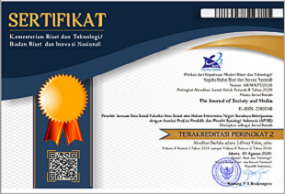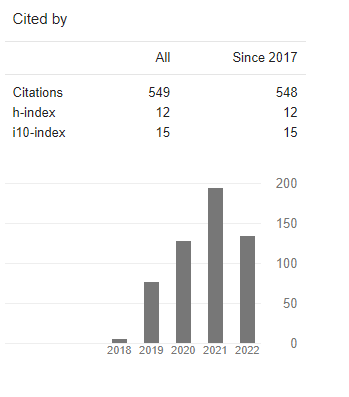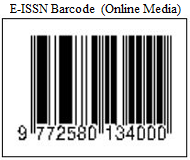Challenges Nigerian Journalists Face in Spotting Fake News
DOI:
https://doi.org/10.26740/jsm.v9n2.p694-737Keywords:
Digital tools, fake news, Nigerian journalists, media literacy, misleading contentAbstract
Historically, Nigerian journalism has contended with socio-political pressures, economic constraints and regulatory threats, but the advent of fake news in the digital age has further complicated the media landscape. This study explored the perspectives of Nigerian journalists on fake news, examining their understanding of its impact, the challenges they encounter in spotting false narratives and the motivations driving the spread. Anchored on Agenda-Setting Theory and supported by the Technology Determinism Theory, the research highlighted how technological advancements have facilitated journalistic practices and allowed misinformation to thrive. Using a quantitative research method, questionnaire was administered to 200 practicing journalists across the six geopolitical regions of the country. Key findings indicate that fake news is widespread, with social media identified as a major driver. Journalists reported a lack of adequate training in verification practices. Existing fact-checking protocols were found to require reinforcement. The study underscored the need for adherence to ethical standards, enhanced media literacy among professionals and the public, collaboration among stakeholders and investment in tools and training to tackle fake news effectively. It recommends a balanced regulation that ensures accountability while safeguarding freedom of expression. Addressing these challenges comprehensively, Nigerian journalism can strengthen its role as a credible source of information and restore public trust in media reporting
References
Abdulahi, A., B. Samadi, and B. Gharleghi. 2014. “A Study on the Negative Effects of Social Networking Sites such as Facebook among Asia Pacific University Scholars in Malaysia.” International Journal of Business and Social Science 5(10):133–145.
https://www.researchgate.net/publication/272490714_A_Study_on_the_Negati ve_Effects_of_Social_Networking_Sites_Such_as_Facebook_among_Asia_Pac ific_University_Scholars_in_Malaysia/
Adams, Z., M. Osman, C. Bechlivanidis, and B. Meder. 2023. “(Why) Is Misinformation a Problem?” Perspectives on Psychological Science 18(6):1436–1463. doi:10.1177/17456916221141344.
Adler, P. S. 2006. “Technological Determinism.” The International Encyclopedia of Organization Studies. https://faculty.marshall.usc.edu/Paul- Adler/research/revisingTechnological%20Determinism.pdf.
Aïmeur, E., S. Amri, and G. Brassard. 2023. “Fake News, Disinformation and Misinformation in Social Media: A Review.” Social Network Analysis and Mining 13(30). https://doi.org/10.1007/s13278-023-01028-5.
Akpan, U. J., S. M. Mkhize, A. A. Adeyiga, and T. L. Ojolo. 2024. “Examining Fake News on WhatsApp Messaging in the Political Ecology of Ado-Ekiti and Akure, South-West Nigeria.” Journal of African Films and Diaspora Studies (JAFDIS) 7(4):5–28. doi:10.31920/2516-2713/2024/7n4a1.
Allcott, H., and M. Gentzkow. 2017. “Social Media and Fake News in the 2016 Election.” Journal of Economic Perspectives 31(2):211–236. https://web.stanford.edu/~gentzkow/research/fakenews.pdf.
American Psychological Association (APA). 2025. “Misinformation and Disinformation.” https://www.apa.org/topics/journalism-facts/misinformation- disinformation/.
Arnaudo, D., B. Barrowman, J. Brothers, L. Reppell, V. Scott, A. Studdart, K. Wainscott, and V. Zakem. 2023. “Countering Disinformation: The Definitive Guide to Promoting Information Integrity.” Consortium for Elections and Political Process Strengthening. https://counteringdisinformation.org/introduction.
Batalha, K. 2020. “Climate, Complacency and American Culture: The Role of Narrative in the Era of the Misinformation amid the Anthropocene.” Bryant University Undergraduate Journal 1(2). https://digitalcommons.bryant.edu/cgi/viewcontent.cgi?article=1000&context=i sbhs/.
Bhattacherjee, A. 2012. Social Science Research: Principles, Methods, and Practices.
University of Florida. https://digitalcommons.usf.edu/cgi/viewcontent.cgi?article=1002&context=oa_t extbooks/.
Buldygin, S. S. 2020. “Criticisms of Technological Determinism in the Study of the Dynamics of Industrial Society in the West.” ResearchGate. doi:10.17223/15617793/453/19.
Calhoun, C. 1992. Habermas and the Public Sphere. MIT Press.
College of Staten Island Library (CSI). 2025. “Misinformation and Disinformation: Thinking Critically about Information Sources.” https://library.csi.cuny.edu/misinformation/.
Dafoe, A. 2015. “On Technological Determinism: A Typology, Scope Conditions, and a Mechanism.” Science, Technology & Human Values 40(6). https://doi.org/10.1177/0162243915579.
Egelhofer, J. L., and S. Lecheler. 2019. “Fake News as a Two-Dimensional Phenomenon: A Framework on Research Agenda.” Annals of the International Communication Association 43(2):97–116. doi:10.1080/23808985.2019.1602782.
Enahoro, B. A. 2019. “Social Media and the Challenges of Curtailing the Spread of Fake News in Nigeria.” In Handbook of Research on Deception, Fake News, and Misinformation Online, 38. doi:10.4018/978-1-5225-8535-0.ch014.
Entman, R. M. 2006. “Framing: Toward Clarification of a Fractured Paradigm.” Journal of Communication 43(1):51–58. https://doi.org/10.1111/j.1460- 2466.1993.tb01304.x.
Fraser, N. 1990. “Rethinking the Public Sphere: A Contribution to the Critique of Actually Existing Democracy.” Social Text 25/26:56–80. https://carbonfarm.us/amap/fraser_public.pdf.
Gray, J., and N. Sullivan. 2023. “Propagandist: Meaning and Examples.” Study.com.
https://study.com/academy/lesson/propagandist-definition-examples-quiz.html.
Greene, C. 2025. “From Fake News to False Memories: Tracing the Consequences of Exposure to Misinformation.” In N. Ribero and B. Zelizer (Eds.), Media and Propaganda in an Age of Disinformation, 160–173. doi:10.4324/9781003474760-9.
Hauer, T. 2017. “Technological Determinism and New Media.” International Journal of English Literature and Social Science 2(2). https://ijels.com/detail/technological-determinism-and-new-media/.
Inobemhe, K., F. Ugber, and T. Santas. 2020. “New Media and the Proliferation of Fake News in Nigeria.” Nasarawa Journal of Multimedia and Communication Studies 2(2):155–168. https://www.researchgate.net/publication/352863583_New_Media_and_the_Pr oliferation_of_Fake_News_in_Nigeria.
Jan, A., Shakirullah, S. Naz, O. Khan, and A. Q. Khan. 2020. “Marshal McLuhan’s Technological Determinism Theory in the Arena of Social Media.” Theoretical and Practical Research in Economic Field 2(22):133–137. doi:10.14505/tpref.v11.2(22).07.
Jibril, U. F., A. T. Ibrahim, and A. M. Ibrahim. 2025. “The Impact of Fake News and Cloned Online Pages on Media Credibility, Public Trust and Societal Cohesion in Nigeria.” New Media and Mass Communication 107:1–16. doi:10.7176/NMMC/107-01.
Johns Hopkins University Library. 2024. “Evaluating Information.”
http://guides.library.jhu.edu/evaluate/.
Mare, A. 2025. “Media and Propaganda in Africa: Cracks, Crevices, and Continuities.” In Media and Propaganda in an Age of Disinformation, 119–
141. Taylor and Francis. https://doi.org/10.4324/9781003474760-7.
Mastrine, J. 2021. “How to Spot Media Bias: Omission of Source.” AllSides.
https://www.allsides.com/blog/how-spot-media-bias-omission-source.
McGlone, M. S. 2005. “Quoted Out of Context: Contextomy and Its Consequences.” Journal of Communication 55(2):330–346. https://doi.org/10.1111/j.1460- 2466.2005.tb02675.x.
Okocha, D. O., S. Akpe, I. E. Rukevwe, and B. Odeba. 2024. “Combating Fake News: How Increased Media Competences Can Curb Disinformation Trends in Nigeria.” In M. Jaakkola, T. Duran-Becerra, and O. B. Onyancha (Eds.), Media and Information Literacy, 103–130. doi:10.26620/uniminuto/978-958-763-705- 2.cap.5.
Omoera, O. S., and T. Uwalaka. 2023. “Fake News as Disruptive Media: A Digital Age Challenge in Nigeria.” Studies in Media and Communication 11(6):208–
221. https://doi.org/10.11114/smc.v11i6.6240.
Quandt, T., L. Frischlich, S. Boberg, and T. Schatto-Eckrodt. 2019. “Fake News.” The International Encyclopedia of Journalism Studies 1(6):1–6. https://doi.org/10.1002/9781118841570.iejs0128.
Stepney, E. S., and C. Lally. 2024. “Disinformation: Sources, Spread and Impact.”
UK Parliament. https://doi.org/10.58248/PN719.
Tsfati, Y., H. G. Boomgaarden, J. Strömbäck, R. Vliegenthart, A. Damstra, and E. Lindgren. 2020. “Causes and Consequences of Mainstream Media Dissemination of Fake News: Literature Review and Synthesis.” Annals of the International Communication Association 44(2):157–173. https://doi.org/10.1080/23808985.2020.1759443.
Wyorkson, H., and D. O. Okocha. 2023. “Prevention of the Spread of Fake News and Hoaxes in Nigeria: From Penalisation to the Promotion of Information Literacy.” Fuoye Journal of Communication 7:215–232. https://www.researchgate.net/publication/379053227_Prevention_of_the_Sprea d_of_Fake_News_and_Hoaxes_in_Nigeria_From_Penalisation_to_the_Promoti on_of_Information_Literacy/.
Yeoman, F., and K. Morris. 2023. “The Agenda-Setting Power of Fake News.” In K. Fowler-Watt and J. McDougall (Eds.), The Palgrave Handbook of Media Misinformation. Palgrave Macmillan. https://doi.org/10.1007/978-3-031-11976- 7_18.
Downloads
Published
How to Cite
Issue
Section
License
Copyright (c) 2025 The Journal of Society and Media

This work is licensed under a Creative Commons Attribution 4.0 International License.
 Abstract views: 157
,
Abstract views: 157
, PDF Downloads: 160
PDF Downloads: 160












